Welcome
PREFACE
In compiling this record of our Robinson lineage from 1620 to 1981, I have taken part of my information
from a record compiled by Blanch (Robinson) Kirkpatrick, a first cousin to Lelia (Robinson) Deves Baldwin.
Other tidbits of information I received fraom a preface written by Inez Faber. My uncle, Ira Robinson, also
gave me odds and ends of information.
Aunt Blanch compiled a rather complete record of all the Robinson descendants since 1620. I have condensed this
record to include not only the direct lineage of our family. Anyone interested in the complete record may
copy it from my copy of Aunt Blanch's record which I have kept.
The American Robinsons begin with a Rev. John Robinson who brought a group of followers to America in 1620. It is
said that he arrived in Massechussetts with two indentured slaves and five casks of wine. He was the uncle
of Jack Robinson, the beginning of our American lineage.
The Robinsons lived near the Washingtons in Virginia. George Washington's letters, which are kept in the library
at Washington D.C. are said to contain much information about the Robinsons of his time.
A number of Robinsons are buried at the Snhilow cemetary 4 1/2miles southease of Carlisle, Kentucky,
near Moorefield in the direction of Sharpburg. It is near the center of a triangle formed by the three towns.
The Robinsons of New Virginia, Iowa, are said to have kept a complete record of the Robinsons since they landed
in America.
The James Robinsons (Generation V) migrated to Albia, Iowa around 1844. My Grandfather William H. Robinson was born
there.
Lucille Deves Edgell Cochran
1981
A very comprehensive genealogy of the Robinson and extended family can be found on Ancestry.com with contributions by Peter Hodson.
Another Robinson line that begins with our line (Jack and Rev John Robinson) can be found at this link on the web. Ezekial Robinson Family Line
GEN I Jack Robinson
Nephew of Rev John Robinson. Jack lived in Virginia and was killed by Indians.
GEN II John Robinson
Settled in Virginia
GEN III George Robinson (It is not known if he is the son or grandson of John. George lived in Virginia.
GEN IV James R. Robinson B. 1667 Married to Catherine Howell
B. 1668 Temworth, Warchichshire, England, United Kingdom D: July 1750 New Castle, Delaware, United States.
When James Capt. Robinson was born on September 3, 1743,
in Springs, Virginia, his father, George, was 51 and his mother,
Mary, was 51. He had one brother and four sisters.
James R. Robinson died on October 27, 1827, in Tennessee having lived a long life of 84 years.
He had one son with Catherine Howell: George Robinson
George Robinson was born in 1692 in New Castle, Delaware, his
father, James, was 25 and his mother, Catherine, was 24. He married
Mary Martha Perkins on March 12, 1726, in Chester Township,
Pennsylvania. They had six children in 23 years. John Robinson
1730-1790, James Capt. Robinson 1743-1827, Sarah Robinson
1745-1746, Catherine Robinson 1749-1750, Martha Robinson 1753-1820.
James R. Robinson died in 1763 in Augusta, Virginia, at the age of 71.
GEN V George Robinson George Robinson was born in 1692 in New Castle, Delaware, his
father, James, was 25 and his mother, Catherine, was 24. He married
Mary Martha Perkins on March 12, 1726, in Chester Township,
Pennsylvania.
GEN VI John R. Robinson 1730 Augusta, Virginia- 1790 Franklin, Co. Kentucky
Married Margaret Barrisford B. 1745 Augusta, Virginia - D. 1821 Franklin, Co. Kentucky. Sisters Jennet Barrisford,
Jane Berrisford. father John Berrisford.
GEN VII James R. Robinson 4th Son of John Robinson. When James R Robinson was born on September 15, 1789, in Franklin, Kentucky, his father,
John, was 59 and his mother, Margaret, was 44. He married Lucinda Kennedy in 1815 in Franklin, Kentucky. Davey Crockett
also married a Kennedy. They had ten children in 19 years.
He moved his family to Albia, Iowa in 1844. died on May 6, 1872, in Albia, Iowa,
having lived a long life of 82 years, and was buried in Monroe, Iowa. Lucinda Kennedy, wife of James R. Robinson
When Lucinda Kennedy was born on April 9, 1794, in Franklin, Kentucky, her father, Ezekial, was 54, and her mother,
Jane, was 44. She married James R Robinson in 1815 in Franklin, Kentucky. They had ten children in 19 years.
She died on October 11, 1862, in Albia, Iowa, at the age of 68, and was buried in Monroe, Iowa.
GEN VIII Robert E. Robinson Robert Ezekiel Robinson,
son of James R. Robinson, was born on December 16, 1816, in Washington, Indiana, his father,
James, was 27 and his mother, Lucinda, was 22. He married Lois Nancy Gilbert on April 8, 1855, in Monroe, Iowa.
They lived near Albia, Iowa. James Robinson the second child of Robert and Lois married Maggie DinwiddleThey had nine children
in 19 years. Laura Robinson 1856-1935 (M. James C. Hogue 1834-1911), James Ezra Robinson 1858-1913 (M. Louise M. Dean 1874-1956), Helen M. Robinson 1861-1909, William H. Robinson 1863-1952
(M. Cora Traxler 1869-1938), Ira Emmet Robinson 1865-1948 (M. Flora Jane Lemly 1872-1966), Jesse Robinson 1867-1891, Lois Olive Robinson 1869-1939 (M. Jacob Hawk 1860-1935),
Lela Robinson 1875-1876, Albert K. Robinson (M. Eddyville A. Skeels 1861-1917)'
1857-1934,
Unverified information.
They had one child, Blanche Robinson who married a Kirkpatrick and lived in Kansas City, Kansas. Her dad, James (Uncle Jim) was a
drunkard and died from drowning in a fishing boat. Blanche never had any children. Ira Robinson, the 4th son of Robert and Lois,
married Flora Lemlay. They had 4 children: Selby, who lived in New York , Lloyd, Fern and Opal.
He died on May 18, 1877, in Monroe, Iowa, at the age of 60, and was buried there.
GEN IX William H. Robinson When William Robinson was born in January 1863 in Iowa, his father,
Robert, was 46 and his mother, Lois, was 24. He married Cora A Traxler on October 5, 1885. Cora was
15 years old at the time. cora's sister, Effie, married Jode Haller, who had
migrated to Plainville, Kansas with William Robinson. They homesteaded on land north of Plainville, Kansas in a dugout that
was infested by snakes. The Hallers homesteaded south of Plainsville, on the
Salina river bottom where eventually oil was discovered. Effie and Jode never had any
children. Will and Cora moved into Plainville and ran a cafe for 8 or 9 years, until it burned down. They left
Plainville in a covered wagon and migrated to Goodland, Kansas, along with their two youngest children, Ira and Gary.
In Goodland, Will went into the real estate business. In 1916 he became mayor of Goodland and held that office for 2 terms. While he
was mayor, the main street of Goodland was paved and the sewer system was put in. In 1920, he built an apartment house and ran
a coal business. Both Will and Cora were active in the First Christian Church of Goodland.
They had seven children in 21 years. Cora died in 1938 and Will died in 1952 at the age of 89. They are both buried in the
Goodland, Kansas cemetary.

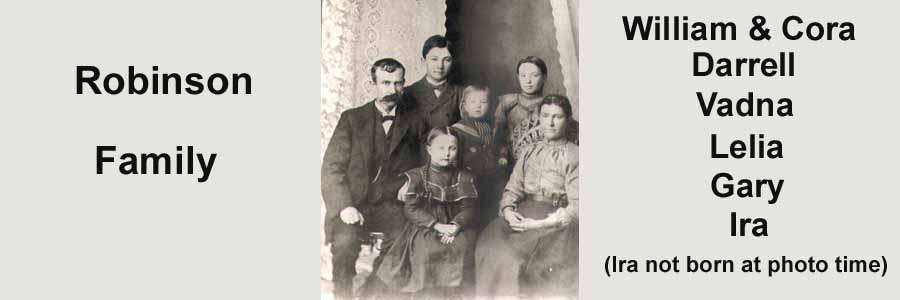



GEN X Darrell M. Robinson 1886-1974
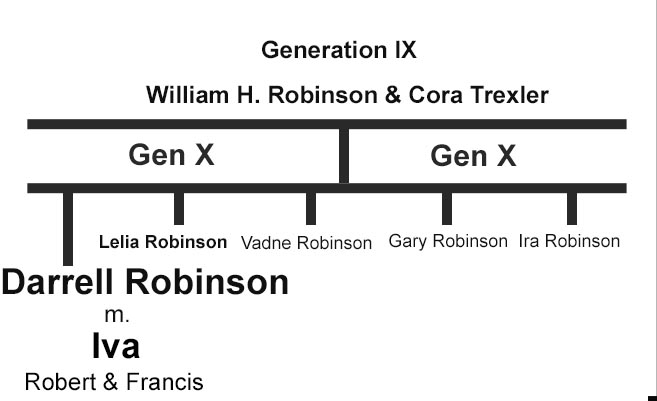
Darrell , 1st child of William and Cora Robinson, married Iva ___. They lived in Kansas City, Missouri,
Omaha, Nebraska, and Portland, Oregon. Darrell taught classes at the Hayes College in Hayes, Kansas for a number
of years. In Kansas City, Darrell became a Civil Engineer. They had two children: William Robert Robinson 1915-1990
and Francis M. Robinson 1917-2007. Francis lived in Portland and had 2 sons. Darryll died in Portland, Oregon 1974.
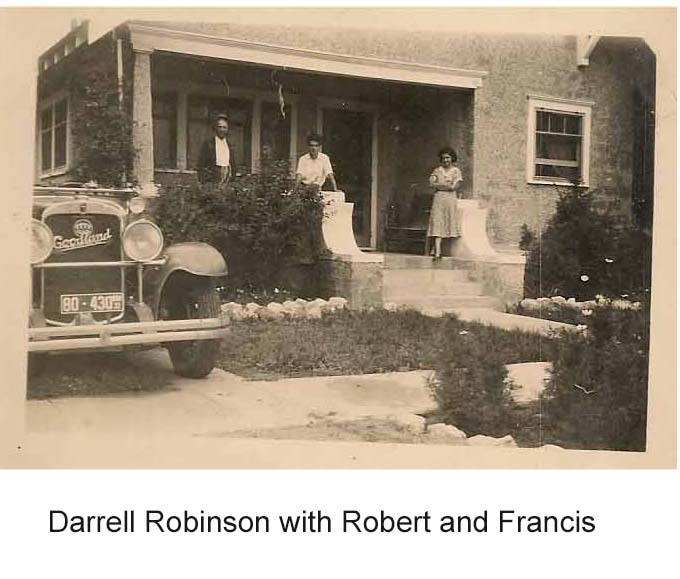


GEN X Vadine (Vadne) Robinson 1888-1977
Vadna Haydes Robinson, 2nd child of William and Cora Robinson, was born March 27, 1888. She married Lewis
Whistler, an army captain in Salina, Kansas. They had one son, Duane, born about 1910. Lewis Whistler killed
several army guards during a hold up at Fort Riley , Kansas, and then committed suicide.
The story of the robbery and ax murders is found on the internet.
A congressional hearing into the events of the night of the robbery was held to determine if one of the victem's wives
should be compensated. The hearing is detailed on the events and accounts of that night. The congressional
record can be found in Appendix A below. Appendix A It is a very interesting read.
Vadne moved back to Goodland for a while and then she lived in Kansas City with Darrell and his wife, Iva. Vadne married a
railroader, Frank Fowler. They moved to Goodland and built a house next door to Will and Cora. Frank Fowler adopted Duane.
In 1950, Frank Fowler died. He is buried in the Goodland plot. In about 1956, Vadne married Nobel Youngblood in Denver, Colorado.
He died within the year. Vadne moved to Palm Springs, California. She died in May 1977 at the age of 89.
She is buried in the Goodland plot.

.jpg)


****************************



Lelia's second husband, Olde Baldwin.


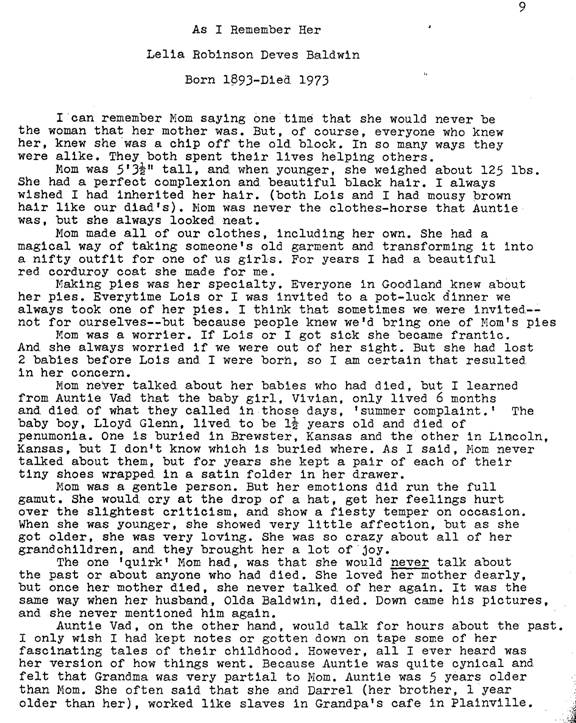

****************************

Lois Marie (Deves) Amos


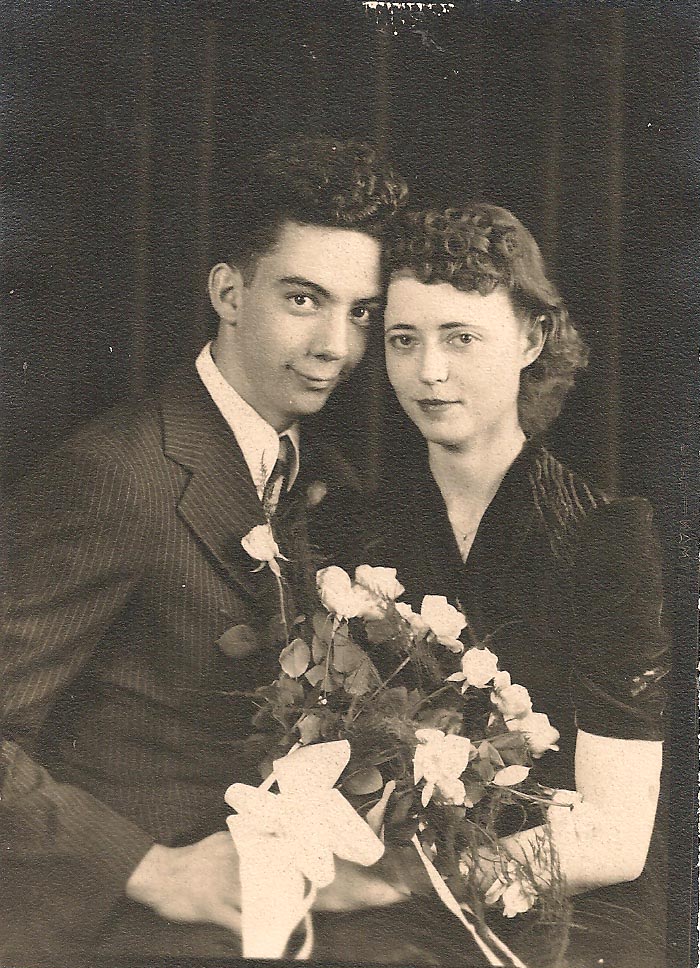
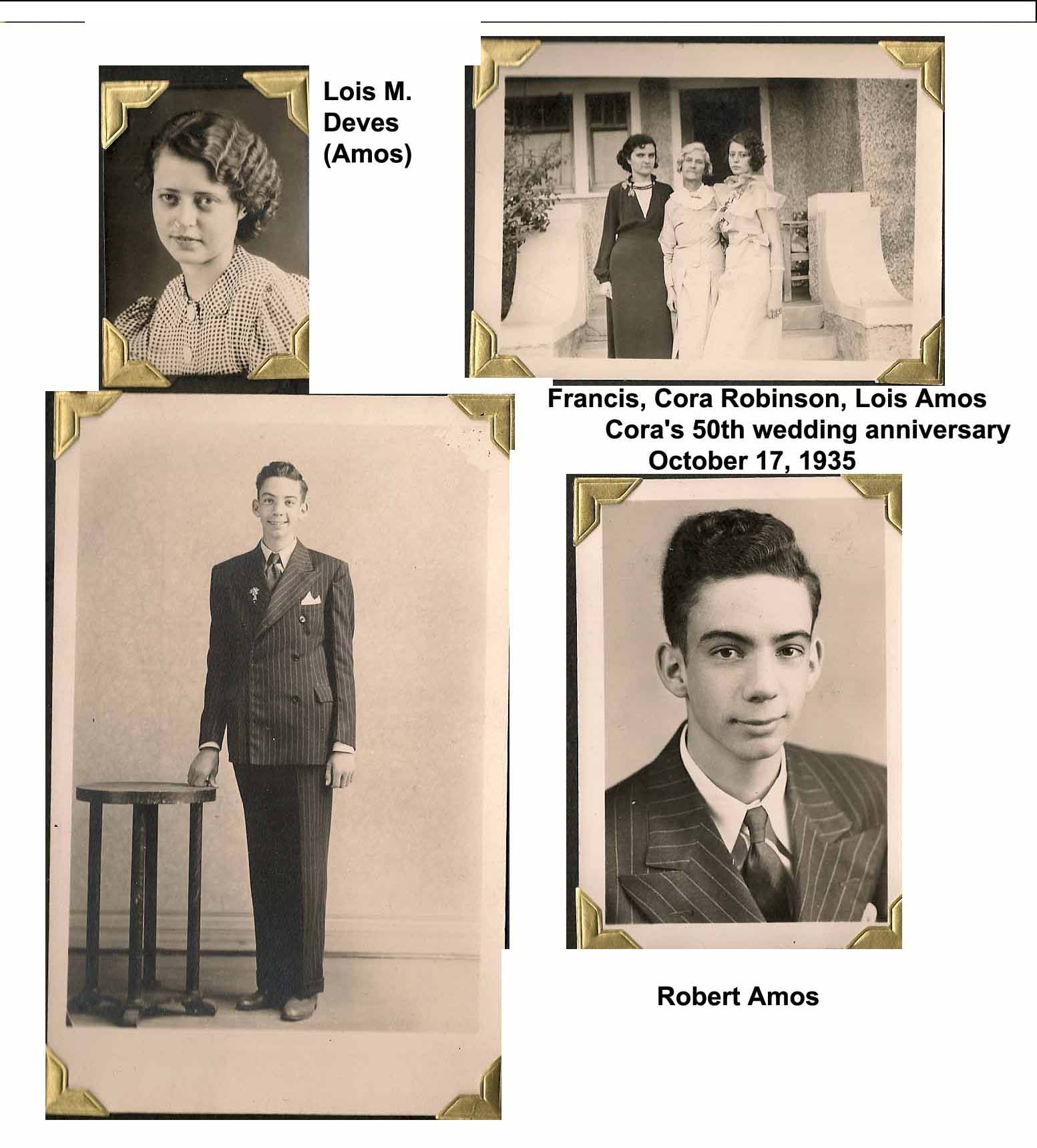


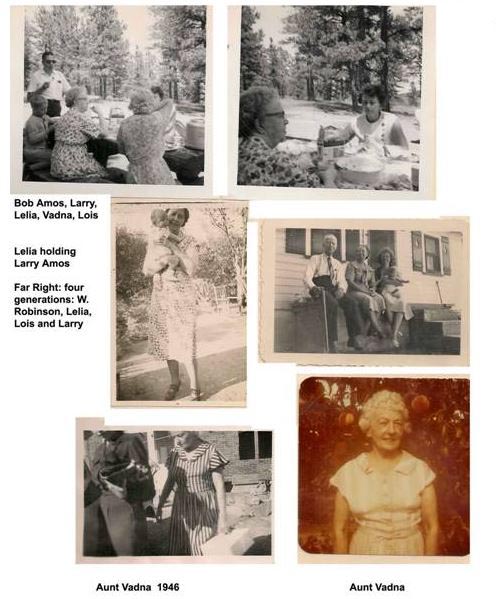




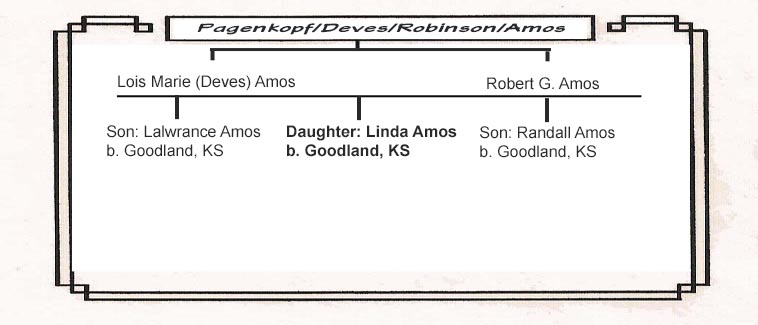



****************************



Lucille was a prolific writer and collector of family stories and photographs and it was deemed necessary to build a site devoted to her
life and collections. Click on the menu item above to experience her life's work.
The Edgell part of her life through marriage also has it's own
section in 'Edgell Genealogy' which follows her three sons by
Forest Edgell: Lynn, Steve and Bob.
Her son by her second husband Robert Cochran (Charles Stanley Cochran) is included in
the Robinson section of this family history and is shown here.


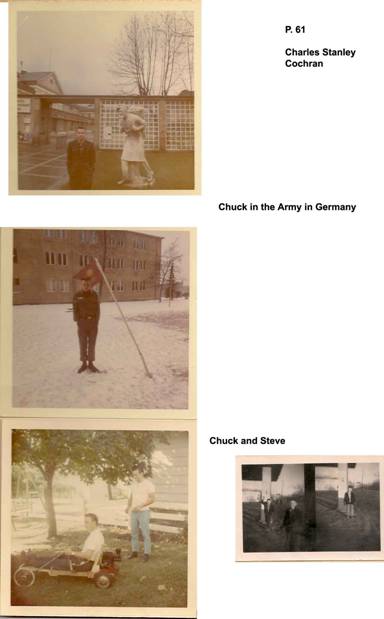
After serving in the military in the 1960s, Chuck settled down and married Sissy. They had three children: daughter Kelly, son Jimmy and son Melvin.
.jpg)
.jpg)


Chuck moved to Phoenix in the late 1980s. He met Cheryl McIntire and they wed, producing a son, Lee Cochran.

****************************
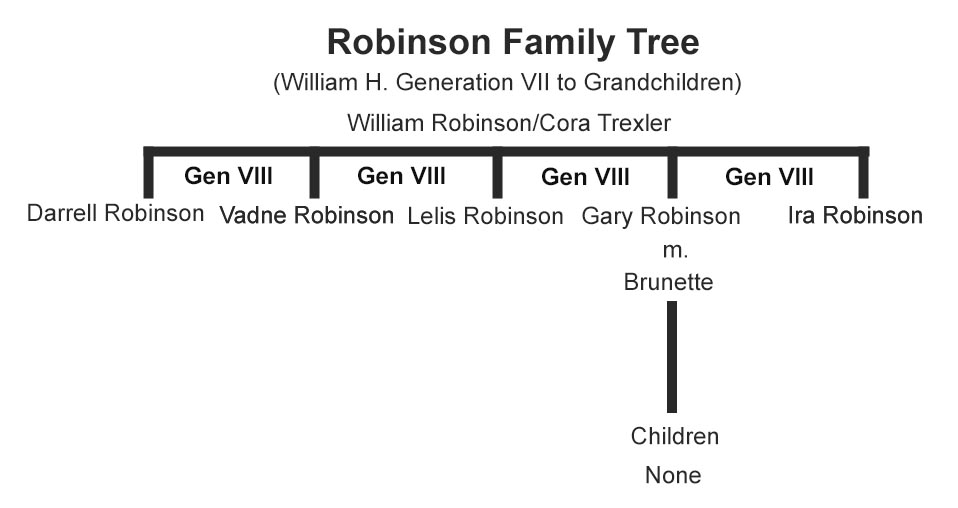
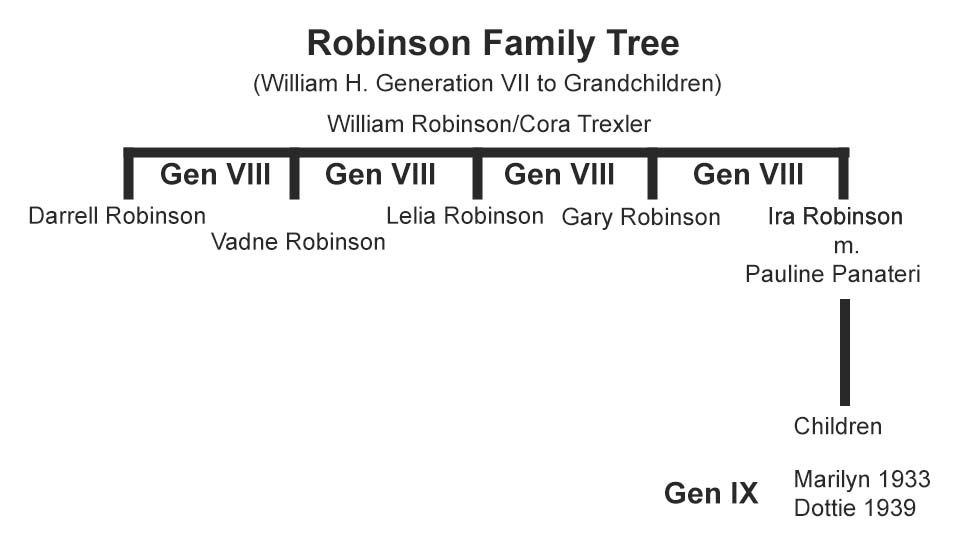
This genealogy section on the Robinson family is a work in process. As new information arrives it will be added. Please let me know if you have a contribution: bob@bedgell.com or robertedgell43@gmail.com
************************
The original transcript of the proceedings is highly detailed in 55 pages of testimony, with extensive details by the guards on duty that night and copies of several supporting documents such as the lease agreement between the military and the bank company. It reads like a mystery novel.
COMMITTEE ON WAR CLAIMS

House of Representatives
SIXTY-SIXTH CONGRESS, THIRD SESSION
BENJAMIN K. FOCHT, Pennsylvania, Chairman
BERTRAND H. SNELL, New York FRANK CLARK, Florida
FREDERICK N. ZIHLMAN, Maryland CHARLES A. MOONEY, Ohio
STUART F. REED, West Virginia JOHN H. WILSON, Pennsylvania
JOHN R. RAMSEY, New Jersey DAVID J. O'CONNELL, New York
JAMES G. STRONG, Kansas PHILIP H. STOLL, South Carolina
ROBERT E. EVANS, Nebraska
DANIEL A. REED, New York
JOHN C. KLECZKA, Wisconsin
Committee on War Claims
House of Representatives,
Wednesday, February 16, 1921
The committee met at 10 a.m., Hon. Benjamin K. Folkt (Chairman) presiding.
(H.R. 6595, Sixty-Sixth Congress, First Session)
A BILL For the relief of Blanch Winters.
Chairman Folkt opened the proceedings by producing a letter from Newton D. Baker, Secretary of War, where he stated that due to the further evidence submitted by Mrs. Winters to the department (not included in the letter) the AG should amend its findings and that Mrs. Winters may appeal to Congress for redress. Congress is hereby requested to investigate the liability of the Government, to wit, the U.S. Army, as to the murder of Charles F. Winters on the base of Camp Funston, Fort Riley, January 11, 1918 and respond to Mrs. Blanch Winters request for redress in the sum of $25,000.
While Charles Winters was at the bank on the base, he was protecting the assets of the Army and Army personnel and was killed by Captain Lewis R. Whisler, Captain of Company E, Three Hundred Fifty Fourth Infantry Regiment. On the night in question, Captain Lewis entered the bank with the intent to rob its contents and during this action killed Mr. Winters with an ax and another employee of the bank. The committee chairman directed Congressman Robert E. Evans (Nebraska) to begin the proceedings whereupon, Evans began to question Lieut. Co. William T. Hunt, Inspector General.
Much of the Inspector General's testimony centered around the guards on the night of the robbery: their routines, routes, what they had access to and what might they be able to observe. During this interrogation, it was ascertained that the guards had performed as per their duty and if they had seen Captain Whisler in or around the bank, it would not have alerted them to challenge the Captain. Congressman Evans then proceeded to introduce into evidence the statements of the guards on duty that night: Private Bosker B. Brady; Private Dan McLaughlin; and Private Charles J. Holt.
Exhibit 1 Testimony Of Privates Brady, McLaughlin and Holt Congressman Robert E. Evans (Nebraska) introduced
Exhibit 1. Most of their statements and testimony centered around the route of the guards and the time line of between 6pm and 8:30pm. Congressman Evans was particularly interested to know if they had seen an officer in the vicinity of the bank and if so, did that officer have a suitcase with him. Privates Brady and McLaughlin both denied seeing a captain; however, Private Holt had seen an officer who was carrying a red suitcase and appeared to be in a hurry. He was unable to provide a description other than that the officer's height was around 5 foot 8 inches. Private Holt stated that he passed the bank at approximately ten minutes to eight. Congressman Evans asked about sounds or light coming from the bank and Holt responded that he was about 30 feet from the bank when he passed it and 'no'............. he didn't hear any sound or see any light.
Upon further interrogation, Holt admitted that he encountered an officer around 11pm and the officer was carrying a red suitcase. Once they passed, the officer began to trot. Holt then notified the MPs and they apprehended the officer. Holt justified his notifying the MPs because he had heard the Army bank had been robbed.
Exhibit 2 Report on the Investigation with Reference to Army Bank Robbery
The full investigation occurred between January 12 and January 22, 1918. The introduction to the report stated that its contents included: the suicide of Captain Lewis Whisler; the recovery of $56,516 from the walls of the room occupied by Capt. Whisler; and a summary of the events and injuries. "As a result of the investigation, it appears that between about 7:30 p.m. and about 8 p.m., on the evening of January 11, 1918, Captain Lewis Whisler, Three hundred and fifty-fourth Infantry, robbed the Army bank situated on the zone in Camp Funston, killing Messrs. Obed M. Hill, Ozark, Okla., and Charles Ohleson, No. 421 South Colorado Avenue, Kansas City, and wounding Messrs. John W. Jewell, Springfield, Mo., and Charles Winters, No. 3532 Baltimore Avenue, Kansas City, so that they died at the base hospital, Fort Riley, Kansas.; the former at about 9.15 p.m., that date, and the latter at about 1 a.m., January 12, 1918, after every possible care and attention had been given to the same, and that Mr. Kearney Wornall, of Kansas City, was dangerously wounded but has since recovered.
That the death and injuries to all the foregoing were due to wounds inflicted by a hand ax in the hands of Capt. Lewis Whisler, Three hundred and fifty-fourth Infantry. In this bank room between the hours approximately above stated. Theories and clues as regards an accomplice or accomplices of Capt. Whisler have been thoroughly investigated without result. The bank officials, based on their first check of their bank books, state that the total amount of money missing is $62,826.21, which leaves an amount of $6,310 shortage."
Exhibit 3 Lease Agreement
Exhibit 3 is a lengthy lease agreement between the quartermaster of Camp Funston and William Huttig of Kansas City to conduct a banking institution on the grounds of the Army base.
Exhibit 4 State of Kansas - State Board of Health - Division of Vital Statistics Standard Certificate of Death
Exhibit 4 contained the details and death certificates of the men killed in the robbery.
There followed the death certificates of Carl W. Ohleson, Obed N. Hill, Charles Fuller Winters, and John W. Jewell.
In all four cases, the cause of death was as follows: 'Shock and hemorrhage produced from traumatic injury to the head, said injuries consisting in contused
lacerated, and incised wounds, fracture of the cranial bones, laceration of the brain tissues, rupture of important nerve centers. Premeditated murder.'
Exhibit 5 Report of investigation of death of John W. Jewell, Carl W. Ohleson, C. Fuller Winters and Abed N. Hill
The report is a summary of the investigation by Major Levi G. Brown of the incident of the bank robbery and noted in the summary was a statement by Kearney Wornall who was in the bank at the time of their injury and was taken to the base hospital where his statement was taken. Captain Lewis Whisler committed suicide at or about 12:45 p.m. on January 12, 1918. On January 16, 1918, $56,600 of the $62,820 taken from the bank on January 11, 1918 was found in Captain Whisler's room. The report then describes the events at the bank. "From the evidence, I find that at or about 7:45 p.m., in the 11th of January, 1918, Carl W. Ohleson and Abed N. Hill were killed and C. Fuller Winters and John W. Jewell were mortally wounded, from which wounds they died, by Capt. Lewis Whisler in manner and circumstances as follows: Capt. Lewis Whisler entered the bank and at the point of a revolver made them lie down with faces down, and had Kearney Wormall tie their hands behind them with rope furnished by Whisler: they were gagged, the bank robbed, and they were beaten and cut over their heads with a hatchet resulting in "contused, lacerated and incised wounds, fracture of the cranial bones, laceration of the brain tissue, rupture of important blood vessels, and the interruption of the normal functions of important nerve centers." which caused death."
The next section of the report described the crime scene in detail and the actions of the medics and hospital in caring for the injured.
This was followed by a sworn statement from Kearney Wornall.
"That he was employed in the Army Bank at Camp Funston, Kansas. On January 11, 1918 after the day's banking business had been done, he was engaged in balancing
in his particular cage at the bank: that it was not customary at the bank to wait on people after the doors were closed. At about 7:30 p.m., the door having been
accidentally left open, and the key had not been turned, when suddenly a captain came in the door, and stepped around the east end of the counter where Winters was
working. He brought a hatched with him, pulled it out of his pocket and tried to hit Winters, but he does not know whether he did or not. After this the captain
stepped around the counter and pulled an automatic gun. He and Winters had a parley over a hold-up. Winters having no idea that this was a hold-up; the same opinion
was held by everyone in the bank except the captain. The captain was much put out that his motives of robbery were not being taken seriously. He took several minutes
in explaining that he was short (he was short in his Company fund account that he was responsible for), and had to be made good, and took this particular time in being
able to make good. He told them they better believe every word he said, that their lives depended on it. Made all of us lie down on top of each other, having picked
out Wornall last for the purpose of tying the others. Wornall tied them all; the captain was not satisfied with the job and tied them tighter. The captain took the rope
out of his pocked and said he had plenty. The captain was fully prepared as to the smallest detail. The hold-up seemed to go very smoothly; he required a particular lamp
to be turned out, and a particular window to be shaded. Winters several times told the men: "We are going to play square with him and let him get away." The captain said
he could get away within an hour. He had gags for each one of the party, and used them in the most brutal way. I, Wornall, laid on my stomach with a gag in my mouth trying
to think of this man's name for 30 minutes. So far as I know he was the only person connected with the affair; saw no one else, if there was anyone on the outside.
The captain in question was about 35 or 40 years old; about 5 feet 10 inches in height; smooth fact; weighed about 150 pounds. Knew he was a captain, as he wore a captain's uniform and insignia, and knew he dealt with the bank in official capacity as captain. He stayed in the bank for half an hour. Took a sack from under the counter and filled it with $20 bills. It may have been Capt. Lewis Whisler, but I am not sure. I do not recollect when the captain hit me; he must have hit me shortly after he hit Winters. I do not remember anything about being struck. Did not see him hit any of the other members of the party; that is, Olson, Hill and Jewell.
Upon viewing the body of Lewis Whistler at 5:45 p.m., who had committed suicide, Kearney Wornall stated under oath that this was the man who came in the Army Bank, Camp Funston, on the evening of January 11, 1918, and committed assault upon Carl Olson, O.N. Hill, Charles Fuller Winters, John W. Jewell, and himself, and robbed the bank of a portion of its funds."
What followed was a report of the death of Capt. Lewis Whisler. Cause of death: Suicide by shooting himself with United States Army rifle. Death was not in line of duty. Death was the result of officer's own misconduct. Body is now in base hospital morgue.
Exhibit 6 Testimony of Corpl. Rae B. Trimmer, Company E
Exhibit 6 is the testimony of a company clerk who testified that the previous Thursday Capt. Whisler asked him to make up an insurance application for him for $10,000 in favor of his son and mail it to his wife at Salina, Kansas, as it would benefit his son more than his wife, being separated from her. Trimmer noted in his statement that the captain acted strange that week and had scattered records all over his desk. He had acted queer and had not greeted Trimmer in his normal, smiling manner. On January 12, the captain came out of his office and asked if they had caught the robbers. At about 15 minutes to one Trimmer and a sergeant went into the orderly room and found the captain's body on the floor.
The previous Wednesday, the captain had the assistant clerk help him with some books and stated that he was short $100 in the company fund.
Exhibit 7 Statement of Private James Lee Newell
The statement of Private Newell is a detailed account of the guard duty on the night of January 11, 1918.
Exhibit 8 Statement of Private Fred Vanderpool
The statement of Private Vanderpool is a detailed account of the guard duty on the night of January 11, 1918.
Exhibit 9 Statement of Private Floyd Herbert Montgomery
The statement of Private Montgomery is a detailed account of the guard duty on the night of January 11, 1918.
Exhibit 10 Letter of inquiry from Rep. Evans to Major Reginald Meade, former Surgeon at Fort Funston
In this letter, Congressman Robert E. Evans (Nebraska) is asking the Major about a telegram he sent to Mrs. Charles Winters regarding the mental state of
Capt. Whisler and wherein it was the belief of Major Meade that Whisler was insane at the time the murders were committed. Evans further asks the Major if
in his opinion, Whisler was unsafe to be at large or to be in charge of men? And if the Major did believe Whisler to be insane and unstable, did the Major
report this to the proper channel?
January 25, 1921
Major Meade responds to the inquiry from Congressman Robert E. Evans (Nebraska).
The Major responds that 4 days before the murder he saw Whisler and that Whisler acted quite peculiar and strange: and didn't seem to understand the courtesies
of the Army. He was making an inquiry about one of the men in his company. The major commented to Whisler that he talked rather insulting for an inferior officer
and Whisler stared at him like an insane man. After his suicide, Col. Richmond found a letter written by Whisler. In the letter Whisler confirmed that he had been
considering suicide and "this gave him a good chance." That confirmed Major Meade's opinion what Whisler was insane.
February 1, 1921
Congressman Robert E. Evans (Nebraska) sends another letter to the Major.
In this letter, Evans poses more questions. Was there negligence on the part of the Government resulting in the death of Charles F. Winters? Did the Major
observe in Whisler's behavior anything that made it the Major's duty to have Whisler restrained? The Major had described Whisler as "criminally insane."
Did the Major believe that Whisler was morally responsible for his acts?
Exhibit 11
Letter from Congressman Evans to Elmer F. Robinson (formerly 1st Lt. Company E.)
January 22, 1921
To a Judge of unknown place or position regarding a letter Lt. Robinson wrote to Evans
In the letter, Robinson stated that shortly after arriving at Funston, Whisler told him his property accounts were not in good shape and he had been charged
with a lot of Government property that he couldn't account for, with no receipts as to their disposition. Whisler was worried. Robinson further stated that
Whisler was a hard worker, not for a moment insane, very agreeable to work with and friendly. Robinson described the night of the robbery. They had attended
an officer's conference at 6:30pm. Later at 9 p.m., after the crime, they went to French class and during the class orders were issued that all officers report
to their companies and check up on the men. The following morning they were both in the officer's barracks until about noon and Robinson stated that he didn't
notice any strange behavior in Whisler. He observed that the officers of Company E knew Whisler better than Major Mead and the officers believed Whisler was normal.
Robinson offered his opinion that the robbery was premeditated since Whisler had prepared his room to hide the money and it took 5 days to find it. He finished by
saying that he didn't believe Whisler robbed the bank with the intention of hurting anyone: however, upon leaving the bank, one of the men tied up said that he knew
Whisler and that they would get him, whereupon Whisler killed them with a hatchet.
January 17, 1921
Letter from Congressman Evans to Lt. Robinson
Congressman Evans is delving further into the question of Whisler's insanity and if the officers had the same opinion as Major Meade and in Robinson's opinion, was
Whisler insane.
February 10, 1921
Letter from Congressman Evans to Lt. Neil Cline
Lt. Cline was assigned to Company E and Congressman Evans is asking the same questions regarding the sanity of Whisler and if any Government officers had
such an opinion. Cline responded that he believed Whisler was insane and that he had been acquainted with Whisler since May of 1917 before they became officers.
He was Whisler's roommate in the same squad room for three months and on several occasions there was a discussion about Whisler and the consensus was that he was crazy.
Whisler had several behavior quirks that reinforced the idea that he was not mentally stable; he would stare blankly for 20-30 minutes; his hobby was signal work and he
would practice it at all hours; he would pace in front of the barracks with an open book. Lt. Cline described how he had gone with Whisler to the French class the
night of the robbery and he seemed in a better mood than his normal self. The next day, after it was announced that one of the injured men told authorities that he
could recognize the robber, Whisler became agitated and worried.
*****
Following this line of questioning by Congressman Evans, Congressmen Bertrand Snell New York and Congressman John C. Kleczka (New York) called for Colonel Hunt to testify. Most of the testimony centered around the transfer of money to the bank, who was responsible for the money and should have there been a special guard. Col. Hunt replied that the banks had safes and the primary reason for guards walking a route and checking doors was for fire protection. The attention was then placed on who was responsible for private property placed on a military installation and Hunt said he was not a legal expert and couldn't give a proper answer. Congressman Kleczka then produced a letter from Lt. Col. H.S. Howland (formerly Assistant Chief of Staff, 89th Division) to Mrs. Blanche Winters dated January 24, 1921. Mrs. Winters had asked if guards or private individuals would be allowed to exercise authority on a military reservation and Howland's answer was a resounding no, the military would never share police control on a military base. When an individual or other entity places assets on a military reservation, they would fall under the government jurisdiction. Also, there are circumstances where an individual or company is allowed to conduct business on a military establishment, he or it falls under the rules and laws of the military.
When General Woods established that zone at Camp Funston, everything and person in that zone, including Mr. Winter's bank, was entitled to protection from the military police. Howland concluded that when the Government funds were deposited in Mr. Winter's bank, the military should have added extra protection to the bank and those funds.
*****
At this point in the hearing, Congressman James G Strong (Kansas) asked Col. Hunt why he held an investigation and Hunt replied that he was asking to insure the guard duties were carried out properly. Congressman Strong pressed him and asked if the purpose of his investigation was to cover up any liability of the Government for the murders of civilians on government property. Hunt dodged the question and Strong persisted by following with an accusation. Wasn't it true that no matter how many guards around the bank, Whisler could have walked right past them? Hunt agreed and reiterated that the guards were for fire protection. Congressman Strong then switched the emphasis and asked Hunt if the bank was in a temporary building at which Hunt responded in the affirmative and described the temporary building as a one room wooden construction. Strong was trying to point out that the conditions of this bank were out of the ordinary, with 20 - 30 thousand soldiers depositing and withdrawing funds and the extra night duties to reconcile these accounts and that extra precautions should have been made.
*****
Congressman Strong then surprised Col. Hunt with the following, "Do you know anything about the loss of a diamond ring on Mr. Winter's finger when he was taken to the
hospital?" Hunt acknowledged that he had investigated the occurrence and found that between the time in the operating room until his death the ring disappeared. Strong
then asked Hunt if he knew the value or a description. Hunt answered that it was a sizeable diamond in the ring, possibly a carat in size.
At this point, Congressman Evans intervened. His main mission in this case was to determine the government's liability with regard to the bank, the murders and now
the ring and he asked Col. Hunt if he considered the government's liability during his investigation: at which point Hunt responded....'no.'
Congressman Evans then took over the line of questioning and directed it to the agreement between the Government and the bank. In the agreement, the bank
agreed to 'carry the necessary insurance against fire, burglary, fixtures and business. Congressman Strong pointed out that if the military took over responsibility
for the private enterprise, why would an agreement require that enterprise to have insurance?
Congressman Reed of West Virginia asked the question if whether or not the bank could have hired their own police protection? Hunt answered he didn't know of any
restrictions for this act. Reed continued.....pointing out that the War Department had full access to the bank and its books so a captain would not have been barred
from the premises at any hour. The conclusion of this testimony was that the bank had the right to have a guard, or guards, inside the bank but not outside the bank.
*****
The next witness to appear before the committee was Captain William P. Montgomery. A captain in the Judge Advocate General's Department in the Army. Before that
assignment he was captain of Infantry at Camp Funston and served as adjutant to the provost marshal, responsible for the general guard and police of the army base.
and before that in civilian life, he was assistant attorney general of Kansas. Montgomery explained to the committee that in November of 1917, he and the provost
marshal determined that there were overlapping duties in the guard unit and the decision was made to develop a permanent cantonment guard who would act as police in
certain zones on the base and not as sentry guards. Each unit within the base would fill that role in their own zone. Thus, before taps, 9 p.m., the guards would not
challenge anyone on the base. After taps they would. The main purpose of Montgomery's statement had to do with where the bank was situated on the base and in which
guard zone it was located. Within that zone were retail outlets; theaters; stores; restaurants; Y.M.C.A. and other stores. The permanent cantonment guards were
responsible for policing that zone: much as a policeman would walk his beat.
Once it was established that the bank was in the zone, the committee pursued the issue of responsibility of guarding the banks on base. It was determined from the
testimony that the guards were not responsible for the bank or its contents: which would necessitate them entering the bank and this was not in their charter.
The conclusion was that the Government was not responsible for the safety of the contents of the banks on base.
In the opinion of Montgomery, if Mr. Winters was working after hours and an officer requested to enter the bank, Mr. Winters would have admitted him.
Congressman O'Connell, representing the state of Montana asked a hypothetical question. "If a band of highwaymen entered the base with the purpose of robbing the bank, would the guards protect the bank?" Montgomery answered in the affirmative stating the guards would protect any property in that instance.
*****
Congressman Evans then introduced a new line to questioning: pertaining to the court martial of Lieutenant Dwyer. Dwyer was a surgeon in the brigade at the time and Capt. Whisler sent one of the men in his company to Dwyer's dispensary for an illness. Dwyer examined the soldier and believing he was a malingerer, marked him as fit for 'double duty' and sent him back to his company. Within three days the soldier died of pneumonia. Captain Whisler initiated court martial action against Dwyer.
*****
Congressman Snell of New York then delved into the question of Captain Whisler being insane. Montgomery said in his testimony he had no opinion as to that description
and it was not a topic among the officers. If there had been a concern, the matter would have landed on his desk.
Congressman Snell of New York introduced an official statement by Lt. Stanley Epstein, a member of Company E, wherein he testified that on the day before
the robbery, Capt Whisler acted strange.....unable to keep his mind on the duties at hand. wildly holding his head, pacing the floor and eventually turning
the Company over to Lt. Epstein. He described Capt. Whisler's demeanor as being abstractness and depression. Lt. Epstein concluded that based on his and others
observations, Capt. Whisler was mentally unbalanced.
*****
Congressman Snell then introduced another statement by a Sergeant of Company E, Sergeant John Sarpy Cabanne҄, wherein he stated that due to Capt. Whisler's personal
peculiarities and unbalanced administration of the company's affairs, he was unsound mind.
Congressman Snell proceeded to introduce another statement, by Neil F. Cline who was in officer's training camp at Fort Riley, Kansas with Capt. Whisler. Affiant
further stated that at the time of the murder he was a second lieutenant in Company E, Capt. Whisler being the captain of the company, that Capt. Whisler manifested
many peculiarities including his manners, looks, orders, and conduct, all which gave every evidence of his being mentally unbalanced.
*****
Congressman Evans then introduced into the record in the case of Vadne Whisler v. Lewis Whisler, granting a divorce to Mrs. Whisler from Lewis Whisler on March 6, 1917. The divorce was granted for reasons of extreme cruelty and the revelation that Lewis Whisler had contracted syphilis at an earlier date. Vadne Whisler was granted sole custody of their son, Duane Elmo Whisler, and awarded alimony in the amount of $12.50 semi-monthly and support for said child in the amount of $15 semi-monthly. In addition, defendant was ordered to pay all taxes on the real estate owned by plaintiff and defendant and all costs relating to the divorce action.
*****
Congressman Snell then produced a letter addressed to him from P.G. Harris, Adjutant General, dated May 11, 1920, wherein AG Harris offered the opinion that the Government was in no moral or legal responsibility relative to the death of Charles Winters. Congressman Snell then produced a letter from Newton D. Baker, Secretary of War, where he stated that due to the further evidence submitted by Mrs. Winters to the department (not included in the letter) the AG should amend its findings and that Mrs. Winters may appeal to Congress for redress.
*****
Committee Chairman Benjamin Folkt then read from a statement of a proceeding on this matter and the enactment by the Senate and House of Representatives to
direct the Secretary of the Treasure to pay Blanch Winters, widow of Charles F. Winters the sum of $25,000 compensation for the loss by death, on January 11, 1918,
at Camp Funston.
The statement further states that While Charles Winters was at the bank protecting the assets of the Army and Army personnel, he was killed by Captain Lewis R. Whistler,
Captain of Company E, Three Hundred Fifty Fourth Infantry Regiment.
Chairman Folkt then adjourned the proceedings.
COMMITTEE ON WAR CLAIMS
House of Representatives
SIXTY-SIXTH CONGRESS, THIRD SESSION
BENJAMIN K. FOCHT, Pennsylvania, Chairman
BERTRAND H. SNELL, New York
FRANK CLARK, Florida
FREDERICK N. ZIHLMAN, Maryland
CHARLES A. MOONEY, Ohio
STUART F. REED, West Virginia
JOHN H. WILSON, Pennsylvania
JOHN R. RAMSEY, New Jersey
DAVID J. O'CONNELL, New York
JAMES G. STRONG, Kansas
PHILIP H. STOLL, South Carolina
ROBERT E. EVANS, Nebraska
DANIEL A. REED, New York
JOHN C. KLECZKA, Wisconsin
*****
Congressman Snell then produced a letter addressed to him from P.G. Harris, Adjutant General, dated May 11, 1920, wherein AG Harris offered the opinion that the Government was in no moral or legal responsibility relative to the death of Charles Winters. Congressman Snell then produced a letter from Newton D. Baker, Secretary of War, where he stated that due to the further evidence submitted by Mrs. Winters to the department (not included in the letter) the AG should amend its findings and that Mrs. Winters may appeal to Congress for redress.
*****
Committee Chairman Benjamin Folkt then read from a statement of a proceeding on this matter and the enactment by the Senate and House of Representatives to direct
the Secretary of the Treasure to pay Blanch Winters, widow of Charles F. Winters the sum of $25,000 compensation for the loss by death, on January 11, 1918, at Camp Funston.
The statement further states that While Charles Winters was at the bank protecting the assets of the Army and Army personnel, he was killed by Captain Lewis R.
Whistler, Captain of Company E, Three Hundred Fifty Fourth Infantry Regiment.
Chairman Folkt then adjourned the proceedings.
Return to Gen X Vadine (Vadne) Robinson 1888-1977"





